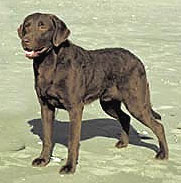|
The Canine Chronicles Directory
Chesapeake Bay Retriever

The Chesapeake Bay Retriever has a slight wavy, short double coat. The outer coat
is coarse, and dense with an oily texture. The undercoat should be thick and wooly.
The coat color can range from shades of brown, red, tan, or dead grass straw color
to deep dark brown with red overtones. When showing this breed, some white is permissible
on the chest, stomach, and feet. The head is broad and domed shaped with a medium
stop and muzzle. The medium sized eyes are well set apart and are generally yellow
or amber in color. The small ears are set well upon the head and hang down on either
side of the skull. The teeth should meet in a scissor or level bite. However, scissor-bite
is preferred when showing the dog. The muscular neck should merge into well laid
back shoulders. The wide chest should be deep and have well sprung ribs. The loins
should be even or slightly higher than the withers. The straight forelegs should
have well developed bones and the hind legs should be strong and the dewclaws removed.
The feet are large and webbed. Removal of the dewclaws on the forelegs is optional.
The tail is either straight or slightly curved.
|
|
Temperament
|
Chesapeake Bay Retrievers are courageous, intelligent, willing, and affectionate.
This breed is extremely friendly although they can be independent and willful at
times. Chesapeake Bay Retrievers love children, however they tend to play roughly
and should be supervised around smaller children. They enjoy being around people
and participating in family life. They are slightly more aggressive than other retriever
breeds and generally reserved around strangers. They may become combative with other
dogs, although socialization will help prevent this behavior. They can get along
with cats already in the household, but will chase cats that they are unfamiliar
with. Chesapeake Bay Retrievers love the outdoors and especially enjoy the water.
This breed is slow to mature reaching adulthood around age three.
|
|
Height, Weight
|
Male Height: 23-26" ; Weight: 65-80 lbs.
Female Height: 21-24" ; Weight: 55-70 lbs.
|
|
Health Problems
|
The most common ailments in this breed are eye problems and hip dysplasia.
|
|
Living Conditions
|
Chessies should not live in an apartment. They do best with a medium to large yard.
If the breed lives in a warm climate, make sure there is a body of water nearby
so that he can cool himself.
|
|
Exercise
|
This breed needs lots of regular exercise that should include swimming when possible.
If they are not exercised enough, they will become bored often to disastrous results.
|
|
Life Expectancy
|
About 10-12 years
|
|
Grooming
|
This breed is easy to groom. Brush with a wire brush to remove dead hair. Bathe
only when necessary as to not strip the natural oils in the skin. This breed is
an average shedder.
|
|
Origin
|
In 1807, a shipwreck occurred off of the coast of Maryland. On the ship were two
Newfoundland puppies which were given to rescuers as a thank you. They were bred
with local dogs and then later crossed with other retriever and hunting breeds including
Flat Coated and Curly Coated Retrievers, Irish Water Spaniels and Coonhounds. They
were developed to work in the water, retrieving fowl and had incredible enthusiasm
and endurance. They have been known to retrieve 200 ducks from frigid waters, in
a single day. In 1885, the breed was standardized and were recognized by the UKC
in 1927 and by the AKC in 1933. They arrived in Britain during the 1930s and became
popular as a gundog during the 1970s.
|
|
Group
|
AKC Sporting, UKC Gun Dog
|